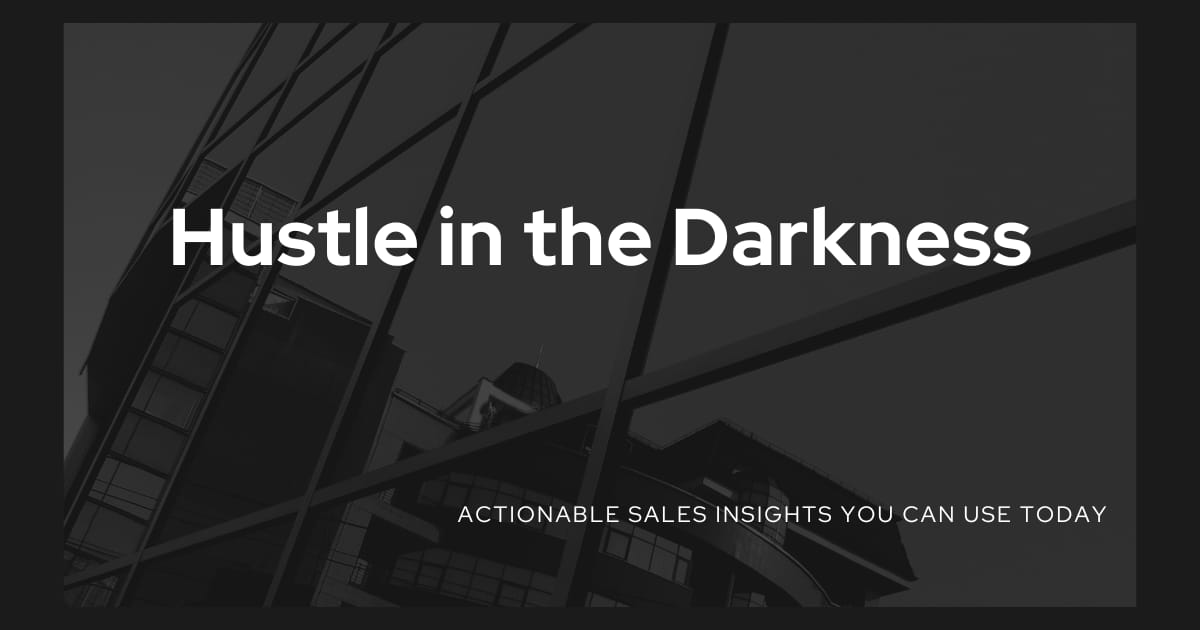Read on: My website
Read time: 2 Minutes
Businesses often blame “outside forces” when things go wrong, regulations change, technology fails, a flight gets canceled, or a key partner drops the ball
The truth? Your customers don’t care whose fault it is. Fix it.
They care what you do next. And how fast and efficiently you move.
In the toughest moments, it isn’t about explanations or finding scapegoats, or the “I’ll get back to you on that." It’s about who owns the solution, acts fast, and makes things right, because accountability is what wins (and keeps) big accounts, and wins the next one.
Was this newsletter forwarded to you?
Control the things that you know you have the ability to control, and don’t try to control the things that you know you can’t.
This week, I’m talking about building on customer engagement during times of uncertainty. Don’t look at blame or finger-pointing; look at ways to build on your relationships and trust with your customers, and more importantly, your internal team.
Let’s dance.
Customer Service is the Name of the Game
In business crisis situations, there's a fundamental disconnect between what internal teams focus on and what customers actually need. Research shows that businesses underestimate the number of times customers have poor experiences by an average of 38%, while 42% of customers with poor service experience disappointment, 43% feel unhappy, and 41% report anger.
The devastating impact of playing the blame game:
67% of customers tell others about bad experiences
65% switch to a different brand after poor service recovery
Meanwhile, companies that focus on accountability see dramatically different outcomes:
82% of customers are more likely to stick with brands that provide value during service interactions
Companies with high customer satisfaction are 1.5 times more likely to outpace competitors
83% of customers feel more loyal to brands that respond to and resolve complaints effectively
Translation: While you're debating who's at fault, your customer is deciding who to call next.
Check out past articles I’ve written on this here:
Communication = Key
Crises are going to hit. When and where, you never know. Having a preliminary plan put together of how to proactively reach out to your customers can solidify comfort and reduce risk in how you work with them.
Not every crisis needs the CEO or senior leadership’s attention. Understanding the relationship of the customer (or a major account) to senior leadership is critical; it can be a courtesy to keep them in the loop, but keeping them in the dark can backfire on you.
Pillar 1: Immediate Response Control
What you can control in the first 12-24 hours:
Communication speed and clarity: Response time matters more than perfect messaging
Internal coordination: Who talks to the customer, when, and with what authority
Information gathering: Facts over assumptions, data over speculation
Resource allocation: What gets dropped to focus on crisis resolution
Tailor to the needs of the customer: How does this matter specifically to them
Give a general overview; however, the customer will want to know how it specifically matters to them.
The research backing: Studies show that response speed has a significant impact on consumer loyalty, with customers rating timely response as the most critical factor in service recovery.
Pillar 2: Executive Escalation Strategy
Understand what overall issues need to be addressed. Sometimes, it is just situational awareness of what is in front of them. Let me know what you are hearing,
For example, if the government goes into a shutdown, for how long? What does that matter to me? Do I still get paid? What do I need to do to continue to support our contracts?
Executives need to be proactive on internal resource allocation and external engagement. Some events require more insight and effort than others.
I worked on an executive response during COVID for a client of mine. In short, it required a proactive effort to reach out to the internal team, our customers, make personal calls to our large customers, and build a plan to let them know where we were, with what information we knew at the time, and how we would keep them informed along the way.
What we did was rehearse what we needed to discuss, what was most important, who from the account team would call whom, any personal calls from the CEO would be made, and how we would address any incoming social media, phone calls, etc.
Then execute on it. Follow up. Inform, follow up, and stay engaged.
Customer service for the win.
I’ve done this again at past companies I worked at, whether the government was shutting down, a key senior leader was leaving, and we needed to address their departure, we were doing a Merger & Acquisition, and customers were curious to know how it was going to affect them, and so forth.
The proactive response needs to be up front, and executives should have an action plan (or hire those who are experts in this field).
Best Practice: Do NOT escalate to execs for minor complaints; it backfires. Script every intervention, lightly rehearse, and keep it brief.
Just Do It
Customers remember who fixed their nightmare, not who explained it. Control is about fast, structured response; ownership is about publicly committing to recovery. In business, reputation is built in the fire, not the conference room.
Own what you can control. Take the hit, solve the problem, and let your results, not your excuses, do the talking.
What the Internet Taught Me This Week
From new tools, recent trends, and market updates, here is what has been on my mind.
Armed Guards and Muscle Milk: Senate Investigation Reveals DOGE Takeover Details. Check it out here
California Governor Newsom signs landmark AI safety bill. Check it out here
Hackers used a fake congressional email to breach federal systems and exploit trust. Check it out here
When the dust settles, nobody remembers the excuses; they remember who owned the outcome.
Crises don’t separate winners from losers. Your response does. Brands that act with speed, clarity, and unapologetic ownership turn mistakes into loyalty and setbacks into expansions. Those who hide behind blame or slow-walk solutions get replaced fast.
Don’t let uncontrollable factors define your story. Double down on what you can control: communication, action, and accountability. That’s how you move from being just another vendor to becoming the partner customers trust most when things go sideways.
Decide who you want to be when it’s your turn in the fire. Then run toward it, and lead.
See you next week.
Whenever You're Ready, Here are 4 Ways I Can Help You:
Unlocking Hidden Potential - Reconnecting with Past Clients for Explosive Growth - Check out my free eBook on how you can find hidden gems in your past clients and help you crush your sales goals.
Build your Sales CRM - Download our free Sales eBook on How Your Sales Team Can Maximize Your CRM Tool. Whether it’s Hubspot, Salesforce, or another CRM tool, make sure you leverage it to your advantage.
Awesome Sales Resources - Transform your sales engagement and capabilities across Social Selling, CRM, Lead Generation, Enablement, and more.
Cribworks Advisor Program - Want more than just resources? Reach out to me and see if our Advisor Program can help you grow your business.

